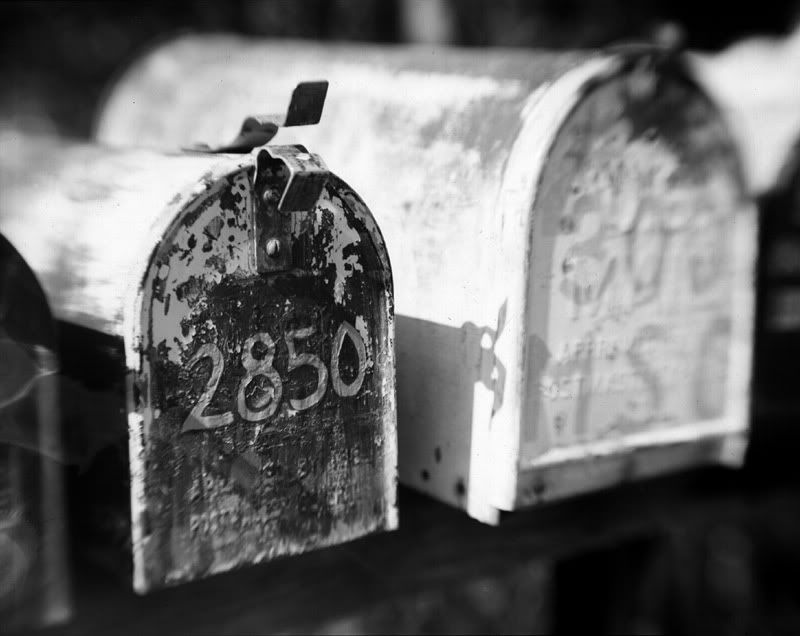David William White
Well-known
A couple of great examples here where the bokah becomes part of the composition (chap in train station is killer, for instance).
For the most part, it is done poorly, and I suggest, as a disservice to the fine optical designers at Zeiss and Leica, etc. I think what really bothers me is how much money people will dump to buy ridiculously expensive precision lenses when they could just as easily stick a LensBaby on the front of some **** lens, or smear vaseline around a UV filter, fix a close-up diopter off kilter, or any other such handy contrivances.
Adding to that is that a rangefinder is one of the most unsuitable instruments for attempting well-considered OOF compositions.
Also, many examples I have seen (even again the chap in the train station) have such good composition and clear attraction points that throwing the background out of focus is hardly necessary. In many cases, the background is not competing at all, or is acting as a delightful and interesting setting that throwing it out of focus is like beating you over the head to look at one and only one thing. If you look at HCB's photographs (or anyone else doing 'street'), or anyone doing 'environmental' portraiture, there are many stories in one photograph, not just one. They survive because they are rich and withstand repeated viewings, wherein you discover little side-stories on successive viewings.
There is a case to be made where the background has no story whatsoever, or worse, where there are trashcans and garbage in the scene, where the shot should have been taken with white seamless in a studio, but rather than throw it out of focus, the adept photographer would have twirled the subject around or taken it from another angle.
So even most portraits can withstand in-focus backgrounds, when arranged with a 'photographers eye'. Portraits don't generally need help.
Some of this is an attempted throwback to pictorialism and to painting, and an attempt to get that 'comfy' feel. However, selective focus was never used in painting, because such a concept could only be introduced by lenses. Most landscape 'pictorial' photographs (which I love and make) do not employ selective focus either -- they are often soft but have infinite depth of field.
Many early photographic portraits have very limited depth of field, but the lenses were generally awful.
It's funny, but rangefinders are ideal instruments for normal to wide lenses (and we have truly enviable wide-angle choices), steadiness at slow shutter speeds, and this makes them best suited to rich, infinite depth of field photographs, yet many seem to go all out to make them perform like long-lens SLR's or view cameras. Go figure.
And for those that want just non-representational modern art, precision photographic equipment, expensive ones at that, seems complete overkill.
A bit of a rant, I know, but I'll just end with a somewhat facetious comment for the bokah diehards: Instead of using your lens 'wide-open', dismount it altogether!
For the most part, it is done poorly, and I suggest, as a disservice to the fine optical designers at Zeiss and Leica, etc. I think what really bothers me is how much money people will dump to buy ridiculously expensive precision lenses when they could just as easily stick a LensBaby on the front of some **** lens, or smear vaseline around a UV filter, fix a close-up diopter off kilter, or any other such handy contrivances.
Adding to that is that a rangefinder is one of the most unsuitable instruments for attempting well-considered OOF compositions.
Also, many examples I have seen (even again the chap in the train station) have such good composition and clear attraction points that throwing the background out of focus is hardly necessary. In many cases, the background is not competing at all, or is acting as a delightful and interesting setting that throwing it out of focus is like beating you over the head to look at one and only one thing. If you look at HCB's photographs (or anyone else doing 'street'), or anyone doing 'environmental' portraiture, there are many stories in one photograph, not just one. They survive because they are rich and withstand repeated viewings, wherein you discover little side-stories on successive viewings.
There is a case to be made where the background has no story whatsoever, or worse, where there are trashcans and garbage in the scene, where the shot should have been taken with white seamless in a studio, but rather than throw it out of focus, the adept photographer would have twirled the subject around or taken it from another angle.
So even most portraits can withstand in-focus backgrounds, when arranged with a 'photographers eye'. Portraits don't generally need help.
Some of this is an attempted throwback to pictorialism and to painting, and an attempt to get that 'comfy' feel. However, selective focus was never used in painting, because such a concept could only be introduced by lenses. Most landscape 'pictorial' photographs (which I love and make) do not employ selective focus either -- they are often soft but have infinite depth of field.
Many early photographic portraits have very limited depth of field, but the lenses were generally awful.
It's funny, but rangefinders are ideal instruments for normal to wide lenses (and we have truly enviable wide-angle choices), steadiness at slow shutter speeds, and this makes them best suited to rich, infinite depth of field photographs, yet many seem to go all out to make them perform like long-lens SLR's or view cameras. Go figure.
And for those that want just non-representational modern art, precision photographic equipment, expensive ones at that, seems complete overkill.
A bit of a rant, I know, but I'll just end with a somewhat facetious comment for the bokah diehards: Instead of using your lens 'wide-open', dismount it altogether!







